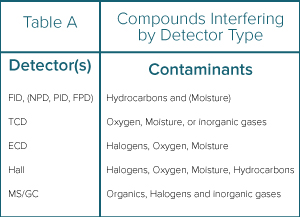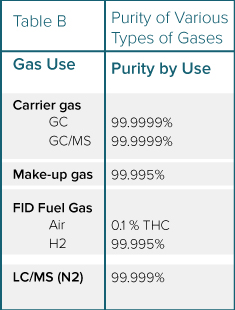
Purifiers are your last line of defense when it comes to keeping out impurities and providing the cleanest and highest purity gas to your gas chromatograph (GC).
You may think that using high-purity gas is enough. But even if you buy high-purity gas, due to a number of possible factors, it's not a certainty that it will be at the same purity when it reaches your GC.
When you change out cylinders, for example, you're at great risk of contaminating the gas. Without check valves in your connection devices or CGA fittings, air can enter your gas system and contaminate it. Leaks are the next largest risk. They develop over time no matter how well you initially sealed all of your connections. That's why continually checking your gas system for leaks during the year is necessary.
To protect your systems from contaminants, we suggest placing purifiers as close to the GC as possible to adsorb contaminants that may enter the system and skew your results. And depending on the different gases you use, you will need a variety of different types of purifiers.


The contents within purifiers used with GC systems can vary. While some purifiers have a simple design and only contain one absorbent, for example, newer purifiers often contain multiple absorbents and may include materials that change color. This indicates whether or not the contaminants are being trapped.
Here are some other important materials that are featured in various purifiers to serve different functions:
Purifiers are available in a variety of sizes, from very small (less than 50 cc) to extremely large with up to 1,000 cc of absorbent material. Not long ago, it was commonly believed that very large purifiers close to the cylinders were ideal for absorbing contaminants that entered the system during cylinder change outs. But studies found this not to be the best practice. It was determined that, after a cylinder change out, as the gas lines were re-pressurizing, the absorbents in large purifiers did not have sufficient time to absorb the contaminants-allowing them to pass through the filter untouched. To correct this, two things were needed: A barrier to hold pressure in the line and a reduction in the volume that would need to be purged-both of which can be accomplished with an internal check valve (CV).
By incorporating the CV in the CGA fitting, only a very small volume of gas will contain any contaminants and that volume is of the order of one ml or less. With the introduction of the CV, we can now use smaller purifiers close to the GC and know we are insuring the purity of our gases.
Oxygen can oxidize surfaces of glass wool and the phases of various columns at higher temperatures. This leads to absorption sites, phase break down and bleeding of phase decomposition compounds onto the detector. These decomposition compounds can coat some detectors or form silane material on the beads and jets of the detector and cause deteriorating performance.
Moisture can lead to hydrolyzation of glass liners, glass wool and, with phases in the column, creation of adsorption sites that may react with polar phases. Many of the capillary phases can handle water in the sample because it elutes very fast and typically at lower temperatures. Water coming from leaks and other sources will be present when the columns reach temperatures where hydrolyzation can occur, causing damage.
The presence of hydrocarbons will show up as peaks in FID and GC/MS analysis. Hydrocarbons may interfere with the elution (co-elution) of peaks or show up as extra peaks in the analysis.
Typically, contaminants enter the gas stream during cylinder change outs. That’s why we used to use very large purifiers by the cylinders and smaller purifiers behind each GC. Today, if you use built-in check valves in your CGA fittings and purifier fittings, the large purifiers are not needed. As always, when it comes to connections in your system, fewer is better because fittings will leak over time.
Leaks develop for several reasons. With some fittings, the connections are made and broken over and over again, wearing down the connection fittings. Leaks will develop in fittings because of temperature changes or because the connection is between different materials, such as brass on copper, or a stainless steel fitting on stainless steel tubing of different composition (such as 316 on 308). Different metals respond to changing temperatures (morning to evening, summer to winter) by expanding or shrinking. Since different metals have differing rates of expansion, leaks will eventually develop.
To help prevent leaks, avoid using fittings of unlike materials or from different manufacturers, and also be mindful of location. Place connections for fittings in areas that are easy to access and specifically avoid the following:
Unneeded connections can also be a problem. That’s why it’s recommended that you design your manifold system to have as few fittings or connections as possible—and today, many new choices are available help make that happen. Installing a check valve into CGA and purifier fittings, for example, reduces the need for other connections and solves many problems. Also, regulators with built-in purifiers have become common and purifiers can even be built inside cylinders.
Many early purifiers were simply long tubes narrowed down to accept compression fittings. They were filled with absorbents and plugged with glass wool. Little has changed with the modern day version of these purifiers, with the exception of frits or the insertion of 10-micron material to stop any of the particles from escaping the tubes.
Many purifiers are made of plastic with metal caps. The metal caps are sealed with O-rings and have some grease on the seals. They are made to be re-filled, but in most cases, the O-rings end up fouled with dust and do not re-seal properly which can cause leaks. These tubes are made of plastic and allow the permeation of hydrogen and helium out and oxygen and moisture in. They should only be used for air lines.
To avoid the permeation problem of plastics, many purifiers are fitted with glass tubes. This works very well and allows for the use of absorbents and indicators.
Many new purifiers come with their own base. You can change them out without turning off the gas because they come with built-in check valves for the cartridges. The base goes into a by-pass mode when no cartridge is present, allowing for the continuation of gas flow.
The selection of the right purifier is still going to be your choice. For more information choosing the right purifiers and other components for your manifold system, ask for a copy of the Airgas Chromatographer's Guide to Gases and Gas Delivery Systems by contacting your Airgas representative or sending an e-mail to us at cleanpeaks@airgas.com.